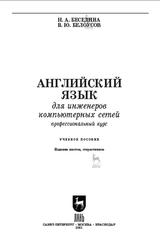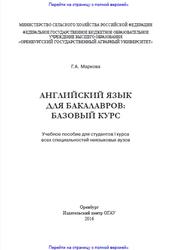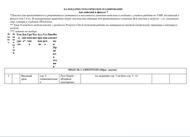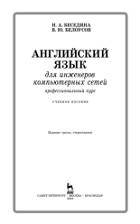Английский язык для инженеров компьютерных сетей, Профессиональный курс, Беседина Н.А., Белоусов В.Ю., 2021.
Данное учебное пособие предназначено для изучения английского языка в области сетевых технологий. Книга содержит оригинальные тексты профессиональной направленности, задания, способствующие усвоению и запоминанию специальной лексики из области сетевых технологий и задания для развития навыков чтения, свертывания информации при составлении рефератов на английском языке, а также формирования иноязычной профессиональной коммуникативной компетенции в условиях профессионального общения.
Пособие рассчитано на студентов, обучающихся по специальности «Сети связи и системы коммутации» и направлению подготовки бакалавриата «Инфокоммуникационные технологии и системы связи», а также всех тех, кто изучает структуру и функционирование локальных вычислительных сетей и глобальной сети Интернет и заинтересован в совершенствовании английского языка в указанной области. Пособие может быть использовано для организации самостоятельной работы студентов.

HOW DOES THE INTERNET WORK?
Even though the Internet is still a young technology, it’s hard to imagine life without it now. Every year, engineers create more devices to integrate with the Internet. This network of networks crisscrosses the globe and even extends into space. But what makes it work?
To understand the Internet, it helps to look at it as a system with two main components. The first of those components is hardware. That includes everything from the cables that carry terabits of information every second to the computer sitting in front of you.
Contents.
Introduction.
Section one THE INTERNET.
Quiz 1.
Unit 1.
Text 1.
The Internet.
Part 1. How does the Internet work?.
Exercises.
Language focus 1.
British and American English.
Unit 2.
Part 2. A Matter of Protocols.
Exercises.
Language focus 2.
Contextual reference.
Unit 3.
Part 3. Packet, Packet, Who’s Got the Packet?.
Exercises.
Language focus 3.
Word formation: Prefixes.
Quiz 2.
Unit 4.
Text 2.
Internet Infrastructure.
Part 1. Introduction to the Internet Infrastructure.
Part 2. The Internet: Computer Network Hierarchy.
Exercises.
Language focus 4.
Word formation: Suffixes.
Unit 5.
Part 3. The Function of an Internet Router.
Part 4. Internet Backbone.
Exercises.
Language focus 5.
Organizing information.
Unit 6.
Part 5. Internet Protocol: IP Addresses.
Part 6. Internet Protocol: Domain Name System.
Exercises.
Language focus 6.
Time sequence.
Unit 7.
Part 7. URL : Uniform Resource Locator.
Exercises.
Language focus 7.
Listing.
Unit 8.
Part 8. Internet Servers and Clients.
Part 9. Ports and HTTP.
Exercises.
Language focus 8.
Giving examples.
Section two THE ETHERNET.
Quiz 3.
Unit 9.
The Ethernet.
Part 1. Introduction to Ethernet.
Part 2. Why Network?.
Part 3. Local Area vs. Wide Area.
Exercises.
Language focus 9.
The passive voice.
Facts and processes.
Events.
Unit 10.
Part 4. The Ethernet.
Part 5. Ethernet Basics.
Part 6. Ethernet Terminology.
Exercises.
Language focus 10.
Explanations and definitions.
Unit 11.
Part 7. Ethernet Medium.
Part 8. CSMA / CD.
Part 9. Collision Detection.
Exercises.
Language focus 11.
Cause and effect.
Unit 12.
Part 10. Limitations of Ethernet.
Part 11. Network elements.
Exercises.
Language focus 12.
Compound noun phrases.
Unit 13.
Part 12. Switched Ethernet.
Part 13. Full duplex Ethernet.
Part 14. Ethernet or 802.3?.
Exercises.
Language focus 13.
If sentences.
Unit 14.
Part 15. Alternative Network Technologies: Token Ring.
Part 16. Alternative Network Technologies: Asynchronous transfer mode.
Exercises.
Language focus 14.
Classifying.
Section three THE SWITCH.
Unit 15.
LAN Switches.
Part 1. Introduction to LAN Switches.
Part 2. Networking Basics.
Part 3. Network Topologies.
Exercises.
Language focus 15.
Function of an item.
Unit 16.
Part 4. The Problem: Traffic.
Part 5. The Solution: Adding Switches.
Part 6. Fully Switched Networks.
Exercises.
Language focus 16.
The Gerund.
Unit 17.
Part 7. Mixed Networks.
Part 8. Routers and Switches.
Part 9. Packet switching.
Exercises.
Language focus 17.
Verbs + Object + Infinitive; Verbs + Object + To infinitive.
Unit 18.
Part 10. Switch Configurations.
Part 11. Transparent Bridging.
Part 12. Redundancy.
Exercises.
Language focus 18.
ing Clauses.
Unit 19.
Part 13. Broadcast Storms.
Part 14. Spanning Trees.
Exercises.
Language focus 19.
Relative clauses with a participle.
Unit 20.
Part 15. Routers and Layer 3 Switching.
Part 16. VLANs.
Part 17. VLAN Trunking Protocol.
Exercises.
Language focus 20.
Warnings.
Section Four WIRELESS NETWORKS.
Quiz 4.
Unit 21.
Text 1.
Bluetooth.
Part 1. Introduction to Bluetooth.
Part 2. Creating a Connection.
Part 3. Bluetooth Operation.
Exercises.
Language focus 21.
Time clauses.
Unit 22.
Part 4. Bluetooth Piconets.
Part 5. Bluetooth Security.
Exercises.
Language focus 22.
Predictions 1 : Certainty expressions.
Quiz 5.
Unit 23.
Text 2.
WiFi.
Part 1. Introduction to WiFi.
Part 2. What Is WiFi?.
Exercises.
Language focus 23.
Giving advice.
Unit 24.
Part 3. WiFi Hotspots.
Part 4. Building a Wireless Network.
Exercises.
Language focus 24.
Requirements: need to, have to, must, be + essential, critical.
Unit 25.
Text 3.
WiMAX.
Part 1. Introduction to WiMAX.
Part 2. WiMAX Wireless Network.
Exercises.
Language focus 25.
Ability : can, could, be able to.
Unit 26.
Part 3. WiMAX Coverage and Speed.
Part 4. WiMAX Cost.
Part 5. WiMAX Technology at Home.
Exercises.
Language focus 26.
Predictions 2: Future perfect and it in subject position.
Answers to Quizzes.
Some opening phrases which can help you with your summary.
List of web"links and bibliography for further reading.
Купить .
Теги: учебник по английскому языку :: английский язык :: Беседина :: Белоусов
Смотрите также учебники, книги и учебные материалы:
 Английский язык, 2 класс, Прописи, Кузовлев В.П., Пастухова С.А., Перегудова Э.Ш., Стрельникова О.В., 2016 — Прописи являются компонентом учебно-методического комплекта Английский язык для учащихся 2 класса общеобразовательных организаций. Они содержат занимательные упражнения, которые формируют у … Книги по английскому языку
Английский язык, 2 класс, Прописи, Кузовлев В.П., Пастухова С.А., Перегудова Э.Ш., Стрельникова О.В., 2016 — Прописи являются компонентом учебно-методического комплекта Английский язык для учащихся 2 класса общеобразовательных организаций. Они содержат занимательные упражнения, которые формируют у … Книги по английскому языку Английский язык, книга для учителя, 2 класс, Верещагина И.Н., Бондаренко К.А., 2016 — Книга для учителя является составной частью учебно-методического комплекта для 2 класса общеобразовательных организаций и школ с углублённым изучением английского языка. … Книги по английскому языку
Английский язык, книга для учителя, 2 класс, Верещагина И.Н., Бондаренко К.А., 2016 — Книга для учителя является составной частью учебно-методического комплекта для 2 класса общеобразовательных организаций и школ с углублённым изучением английского языка. … Книги по английскому языку Поурочные разработки по английскому языку, 5 класс, Наговицына О.В., 2017 — В пособии представлены поурочные разработки по английскому языку для 5 класса к УМК Ю. Е. Ваулиной, Дж. Дули и др. … Книги по английскому языку
Поурочные разработки по английскому языку, 5 класс, Наговицына О.В., 2017 — В пособии представлены поурочные разработки по английскому языку для 5 класса к УМК Ю. Е. Ваулиной, Дж. Дули и др. … Книги по английскому языку Английский язык для бакалавров, базовый курс, Маркова Г.А., 2016 — Учебное пособие содержит задания по лексике, грамматике, чтению, переводу и говорению для развития навыков устной и письменной речи. Предназначено для … Книги по английскому языку
Английский язык для бакалавров, базовый курс, Маркова Г.А., 2016 — Учебное пособие содержит задания по лексике, грамматике, чтению, переводу и говорению для развития навыков устной и письменной речи. Предназначено для … Книги по английскому языку
 English, 7 класс, Karpiuk O. — Фрагмент из книги: When you learn a language, you have to learn different tenses. While revising or learning a tense … Книги по английскому языку
English, 7 класс, Karpiuk O. — Фрагмент из книги: When you learn a language, you have to learn different tenses. While revising or learning a tense … Книги по английскому языку Календарно-тематическое планирование, Английский в фокусе — Лексика для продуктивного и рецептивного (активного и пассивного) усвоения выделена в учебнике с учетом работы по УМК Английский в фокусе … Книги по английскому языку
Календарно-тематическое планирование, Английский в фокусе — Лексика для продуктивного и рецептивного (активного и пассивного) усвоения выделена в учебнике с учетом работы по УМК Английский в фокусе … Книги по английскому языку Английский язык, 9 класс, английский язык нового тысячелетия, Гроза О.Л., Дворецкая О.В., Казырбаева Н.Ю., 2007 — УМК “Английский язык нового тысячелетия для 9-го класса является составной частью учебного курса Английский УМК нового тысячелетия для учащихся 5-11-х … Книги по английскому языку
Английский язык, 9 класс, английский язык нового тысячелетия, Гроза О.Л., Дворецкая О.В., Казырбаева Н.Ю., 2007 — УМК “Английский язык нового тысячелетия для 9-го класса является составной частью учебного курса Английский УМК нового тысячелетия для учащихся 5-11-х … Книги по английскому языку Мистер Хэлп идет на помощь, Нaрру English.ru, 7 класс, Кауфман К.И., Кауфман М.Ю., 2008 — Мистер Хэлп идет на помощь, Нaрру Engfish.ru, 7 класс, Кауфман К.И., Кауфман М.Ю., 2008. Пособие Мистер Хэлп идет на помощь” … Книги по английскому языку
Мистер Хэлп идет на помощь, Нaрру English.ru, 7 класс, Кауфман К.И., Кауфман М.Ю., 2008 — Мистер Хэлп идет на помощь, Нaрру Engfish.ru, 7 класс, Кауфман К.И., Кауфман М.Ю., 2008. Пособие Мистер Хэлп идет на помощь” … Книги по английскому языку




